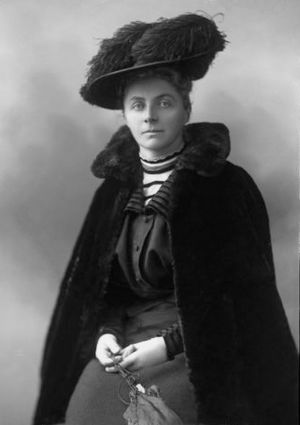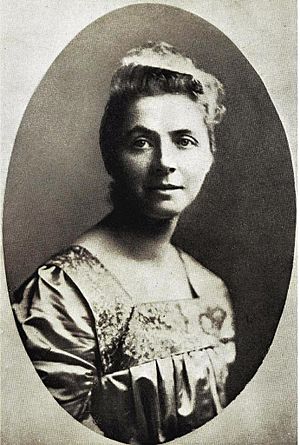Emily Hobhouse facts for kids
Quick facts for kids
Emily Hobhouse
|
|
|---|---|

Emily Hobhouse photographed by Henry Walter Barnett in 1902
|
|
| Born | 9 April 1860 St Ive, Cornwall, England
|
| Died | 8 June 1926 (aged 66) Kensington, London, England
|
| Occupation | Welfare campaigner; humanitarian activist |
| Parent(s) | Reginald Hobhouse (father) Caroline Trelawny |
| Relatives | Leonard Trelawny Hobhouse (brother) |
Emily Hobhouse (9 April 1860 – 8 June 1926) was a British welfare campaigner, anti-war activist, and pacifist. She is primarily remembered for bringing to the attention of the British public, and working to change, the deprived conditions inside the British concentration camps in South Africa built to incarcerate Boer and African civilians during the Second Boer War.
Contents
Early life
Born in St Ive, near Liskeard in Cornwall, she was the daughter of Caroline (née Trelawny) and Reginald Hobhouse, an Anglican rector and the first Archdeacon of Bodmin. She was the sister of Leonard Trelawny Hobhouse, a peace activist and proponent of social liberalism. She was a second cousin of the peace activist Stephen Henry Hobhouse and was a major influence on him.
Her mother died when she was 20, and she spent the next fourteen years looking after her father who was in poor health. When her father died in 1895 she went to Minnesota to perform welfare work amongst Cornish mineworkers living there, the trip having been organised by the wife of the Archbishop of Canterbury. There she became engaged to John Carr Jackson and the couple bought a ranch in Mexico but this did not prosper and the engagement was broken off. She returned to England in 1898 after losing most of her money in a speculative venture. Her wedding veil (which she never wore) hangs in the head office of the Oranje Vrouevereniging (Orange Women's Society) in Bloemfontein, the first women's welfare organisation in the Orange Free State, as a symbol of her commitment to the uplifting of women.
Second Boer War
When the Second Boer War broke out in South Africa in October 1899, a Liberal MP, Leonard Courtney, invited Hobhouse to become secretary of the women's branch of the South African Conciliation Committee, of which he was president.
She founded the Distress Fund for South African Women and Children, and sailed for the Cape Colony on 7 December 1900 to supervise its distribution, and arrived on 27 December.
When she left England, she only knew about the concentration camp at Port Elizabeth, but on arrival found out about the many other concentration camps (45 in total). She had a letter of introduction to the British High Commissioner, Alfred Milner, from her aunt, the wife of Arthur Hobhouse, himself the son of Henry Hobhouse, Permanent Under-Secretary at the Home Office under Sir Robert Peel, and who knew Milner. From him she obtained the use of two railway trucks, subject to the approval of the army commander, Lord Kitchener, which she received two weeks later, although it only allowed her to travel as far as Bloemfontein and take one truck of supplies for the camps, about 12 tons.
Conditions in the British concentration camps
She had persuaded the authorities to let her visit several British concentration camps and to deliver aid. Her report on conditions at the camps, set out in a report entitled "Report of a Visit to the Camps of Women and Children in the Cape and Orange River Colonies", was delivered to the British government in June 1901. As a result, a formal commission was set up and a team of official investigators headed by Millicent Fawcett was sent to inspect the camps. Overcrowding in bad unhygienic conditions due to neglect and lack of resources were the causes of a mortality rate that in the eighteen months during which the camps were in operation reached a total of 26,370, of which 24,000 were children under sixteen and infants, i.e. the rate at which the children died was some 50 a day.
Late in 1901 the camps ceased to receive new families and conditions improved in some camps; but the damage was done.
Bloemfontein Concentration Camp
What most distressed Hobhouse was the sufferings of the undernourished children. Diseases such as measles, bronchitis, pneumonia, dysentery and typhoid had invaded the camp with fatal results. The very few tents were not enough to house the one or more sick persons, most of them children.
When Hobhouse requested soap for the people, she was told that soap was a luxury. She nevertheless succeeded, after a struggle, to have it listed as a necessity, together with straw, more tents and more kettles in which to boil the drinking water.
Hobhouse also visited camps at Norvalspont, Aliwal North, Springfontein, Kimberley and Orange River.
Fawcett Commission
When Hobhouse returned to England she received scathing criticism and hostility from the British government and many of the media, but eventually succeeded in obtaining more funding to help the Boer civilians. The British Liberal leader at the time, Sir Henry Campbell-Bannerman, denounced what he called the "methods of barbarism". The British government eventually agreed to set up the Fawcett Commission to investigate her claims, under Millicent Fawcett, which corroborated her account of the shocking conditions. Hobhouse returned to Cape Town in October 1901, was not permitted to land and was eventually deported five days after arriving, no reason being given. She felt she never received justice for her work. Early the next year Hobhouse went to Lake Annecy in the French Alps where she wrote the book The Brunt of the War and Where it Fell on what she had seen during the war in South Africa.
Rehabilitation and reconciliation
After the war Hobhouse returned to South Africa where she saw that her mission was to assist in healing the wounds inflicted by the war and to support efforts aimed at rehabilitation and reconciliation. With the help of Margaret Clark she decided to set up a home industries scheme with the first being in Philippolis and to teach young women spinning and weaving and lace making so they would have an occupation in their lonely homes. Ill health, from which she never recovered, forced her to return to England in 1908. She travelled to South Africa again in 1913 for the inauguration of the National Women's Monument in Bloemfontein but had to stop at Beaufort West due to her failing health. Her speech which called for reconciliation and goodwill between all races was read for her and received great acclaim. It was during her time there that she met Mahatma Gandhi.
Later life
Hobhouse was an avid opponent of the First World War and protested vigorously against it. She organised the writing, signing and publishing in January 1915 of the "Open Christmas Letter", addressed "To the Women of Germany and Austria". Through her offices, thousands of women and children were fed daily for more than a year in central Europe after this war. South Africa contributed liberally towards this effort, and an amount of more than £17,000 (nearly £500,000 today) was collected by Mrs. President Steyn (who was to remain a lifelong friend) and sent to Hobhouse for this purpose.
South African honorary citizenship
She became an honorary citizen of South Africa for her humanitarian work there. Unbeknown to her, on the initiative of Mrs R. I. Steyn, a sum of £2,300 was collected from the Afrikaner nation and with that Emily purchased a house in St Ives, Cornwall, which now forms part of Porthminster Hotel. In this hotel a commemorative plaque, situated within what was her lounge, was unveiled by the South African High Commissioner, Mr Kent Durr, as a tribute to her humanitarianism and heroism during the Anglo Boer War
Death
Hobhouse died in Kensington in 1926. Her ashes were ensconced in a niche in the National Women's Monument at Bloemfontein, where she was regarded as a heroine. Her death went unreported in the Cornish press.
Legacy
The southernmost town in Eastern Free State is named Hobhouse after her.
The SAS Emily Hobhouse, one of the South African Navy's three Daphné class submarines, was named after her in 1969. In 1994, after the end of minority rule, the submarine was renamed the SAS Umkhonto.
In Bloemfontein, South Africa, the oldest residence on the campus of the University of the Free State is named after Hobhouse.
There is a statue of Hobhouse at the parish church at St Ive, Cornwall, where she was born.
In 1990 Dirk de Villiers directed the South African film That Englishwoman: An Account of the Life of Emily Hobhouse with Veronica Lang as Emily.
The 2021 film The King's Man features a character named Emily Oxford, who bears a strong resemblance to Hobhouse. She is depicted as an activist criticizing the conditions of Britain's concentration camps in South Africa during the Second Boer War.
See also
 In Spanish: Emily Hobhouse para niños
In Spanish: Emily Hobhouse para niños
- List of peace activists


